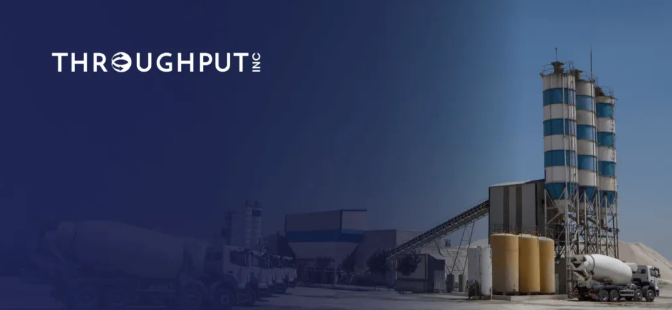Accelerating Cement Supply Chains: How Intelligence Boosts Material and Cash Flow
The cement industry is the backbone of construction, infrastructure development, and economic growth. However, this crucial sector faces significant supply chain challenges that can impede its efficiency and profitability. By leveraging intelligence and advanced technologies, companies like Throughput Inc. can accelerate cement supply chains, optimizing material flow and enhancing cash flow. This article explores the Logistics Challenges In The Cement Industry and presents strategies to optimize cement transport and logistics.
Logistics Challenges in the Cement Industry
The cement industry's supply chain is complex and multifaceted, involving multiple stages from raw material extraction to the delivery of the final product. Some of the primary logistics challenges include:
-
High Transportation Costs: Cement is a low-value, high-volume product, making transportation costs a significant portion of total expenses. Efficient logistics are crucial to minimize these costs.
-
Seasonal Demand Fluctuations: Demand for cement varies seasonally, often peaking during construction booms and declining during off-seasons. Managing inventory levels to match these fluctuations without incurring excess storage costs is challenging.
-
Infrastructure Constraints: Poor road conditions, limited rail connectivity, and inadequate port facilities can delay transportation and increase costs.
-
Supply Chain Visibility: Lack of real-time data and transparency across the supply chain can lead to inefficiencies, delays, and increased operational costs.
-
Environmental Regulations: Stricter environmental regulations necessitate sustainable practices, adding another layer of complexity to supply chain management.
Cement Transport Optimization
Optimizing Cement Logistics transport is crucial for reducing costs and improving efficiency. Here are some strategies that can help:
-
Route Optimization: Using advanced algorithms and real-time data, companies can determine the most efficient routes for transportation. This reduces travel time, fuel consumption, and overall costs.
-
Fleet Management: Implementing intelligent fleet management systems can optimize vehicle utilization, monitor maintenance needs, and ensure timely deliveries.
-
Intermodal Transportation: Combining different modes of transport, such as road, rail, and sea, can optimize costs and efficiency. For instance, rail transport can be more cost-effective for long distances, while road transport is suitable for last-mile delivery.
-
Collaborative Logistics: Partnering with other companies to share transportation resources can reduce costs and improve efficiency. Collaborative logistics platforms can facilitate such partnerships.
-
Real-Time Tracking: Implementing GPS and IoT devices for real-time tracking of shipments can improve visibility, reduce delays, and enhance customer satisfaction.
Cement Logistics
Efficient logistics management is vital for the cement industry's profitability. Here are some key aspects to consider:
-
Inventory Management: Balancing inventory levels to match demand fluctuations without incurring excess storage costs is critical. Advanced inventory management systems can help optimize stock levels.
-
Warehouse Optimization: Efficient warehouse operations, including layout optimization and automated storage and retrieval systems, can reduce handling times and improve throughput.
-
Supply Chain Integration: Integrating various stages of the supply chain, from raw material suppliers to end customers, can enhance coordination and efficiency. This integration can be achieved through advanced ERP systems and supply chain management software.
-
Demand Forecasting: Accurate demand forecasting using predictive analytics can help align production and inventory levels with market demand, reducing wastage and improving efficiency.
-
Sustainability Practices: Implementing sustainable practices, such as using alternative fuels and optimizing energy consumption, can reduce environmental impact and comply with regulations.
Cement Industry Challenges
The cement industry faces several challenges that can impact supply chain efficiency. Some of these challenges include:
-
Raw Material Sourcing: Securing a consistent and high-quality supply of raw materials, such as limestone and gypsum, is crucial for production continuity.
-
Energy Costs: Cement production is energy-intensive, and fluctuating energy prices can impact profitability. Efficient energy management is essential to control costs.
-
Labor Shortages: Skilled labor shortages can affect production and logistics operations. Investing in training and automation can mitigate this issue.
-
Regulatory Compliance: Compliance with environmental and safety regulations is essential but can be costly and complex. Companies need to stay updated with regulatory changes and implement necessary measures.
-
Global Competition: The cement industry is highly competitive, with global players vying for market share. Companies must continuously innovate and optimize their operations to stay competitive.
Cement Supply Chain Issues
Addressing supply chain issues is vital for the cement industry's success. Some common issues include:
-
Supply Chain Disruptions: Natural disasters, geopolitical events, and pandemics can disrupt supply chains. Building resilience through diversified sourcing and contingency planning is crucial.
-
Data Silos: Lack of integrated data across the supply chain can hinder visibility and decision-making. Implementing integrated supply chain management systems can break down these silos.
-
Supplier Reliability: Dependence on a few key suppliers can be risky. Diversifying the supplier base and establishing strong relationships can enhance reliability.
-
Logistics Bottlenecks: Bottlenecks in transportation and warehousing can delay deliveries and increase costs. Continuous monitoring and optimization of logistics operations are essential.
-
Customer Expectations: Increasing customer expectations for faster deliveries and real-time updates require efficient logistics and supply chain management.
Cement Industry Supply Chain
Optimizing the Cement Industry Challenges involves several strategies:
-
Digital Transformation: Embracing digital technologies, such as IoT, AI, and blockchain, can enhance visibility, transparency, and efficiency across the supply chain.
-
Process Automation: Automating repetitive tasks, such as order processing and inventory management, can reduce errors and improve efficiency.
Visit us :- https://throughput.world/blog/how-throughput-accelerates-the-bottom-line-despite-logistics-challenges-in-the-cement-industry/


Comments
Post a Comment